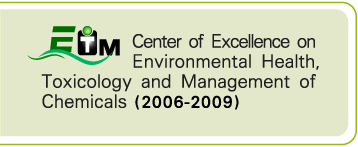|
Although jatropha seed cake contains high amount of protein and other nutrients, but it also has a drawback due to toxic compounds. There are many toxic compounds in jatropha seed cake that include phytate, saponin, trypsin inhibitor, curcin and phorbol esters. However this paper was interested to study on phorbol esters since at even small amount of feeding the seed cake in animal, it can be toxic, and phorbol esters are known for their tumor promoting activity. Moreover phorbol esters are very difficult to break down, but the others toxic compounds of jatropha seed cake can be destroyed by heat alone. Therefore the aim of this study is to identify the potential treatments for reducing the level of phorbol esters. In this study, the treatments were developed with physical (heat from sunlight at 40°C and drying oven at 80 to 220°C), chemical (bentonite, zeolite, zinc oxide nano particle, and sodium bicarbonate). The treated seed cake were analyzed as per standard method of AOAC, 2000 for the selected nutritional parameters such as crude protein (CP), crude lipid (CL) and crude fiber (CF) as well as phorbol esters level and cytotoxicity tests were also determined and compared to identify the potential treatments. We found that heat treatments at either 120°C or 220°C for 1 hour and then mixed with adsorbing bentonite (10%), nanoparticles of zinc oxide (100 ppm) plus NaHCO3 at 4% following by a 4 week incubation period yielded the best final product. The remaining phorbol esters concentration (0.05-0.04 mg/g) from this treatment was less than that reported for nontoxic jatropha varieties (0.11-0.27 mg/g). Nutritional values of the cake after treatment remained at the same level found in the control. These included crude protein (20.47-21.40+0.17-0.25%), crude lipid (14.27-14.68+0.13-0.14%) and crude fiber (27.33-29.67+0.58%). Cytotoxicity tests using a L929 cell line confirmed that most of toxic compounds especially phorbol esters were completely eliminated. The results suggested that the detoxification of phorbol esters residues in the jatropha seed cake was possible while also retaining nutritional values, and jatropha seed cake can be used as a valuable product like an animal feed supplement. However additional tests such as digestibility as well as acceptability of the treated jatropha seed cake as a material for animal food source should be continued using both in vivo and in vitro studies before recommendation as a substitute for soybean meal. Moreover, this research aims to indicate that a large volume of jatropha and toxic phorbol esters will be eliminated through aerobic composting method and the composting process was finished within 12 weeks. The results showed that the application of 4% NaHCO3 for composted jatropha seed cake within 12 weeks can be decreased phorbol esters to 83.33% (0.10 mg/g) and has the highest germination rate (94.30%). Conclusively, aerobic composting technique mixed 4%NaHCO3 is considered to reduce jatropha toxins or phorbol esters, and jatropha fertilizer can be potentially useful for application in agriculture. แหล่งข้อมูล:
|
 Center of Excellence on Environmental Health and Toxicology (EHT)
Center of Excellence on Environmental Health and Toxicology (EHT)










